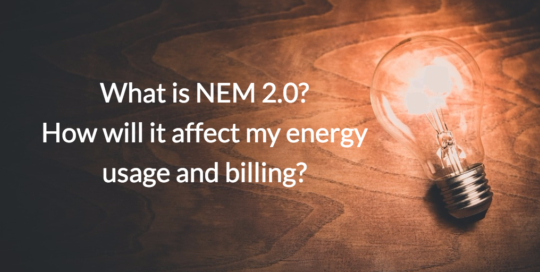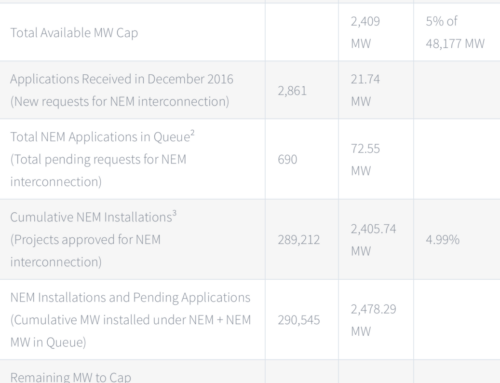The California Public Utilities Commission (CPUC) voted 3-2 on January 28th to adopt a modified Proposed Decision (PD) for the Net Energy Metering (NEM) successor tariff, known as NEM 2.0.
The NEM Program has a megawatt (MW) limit set at 5% of PG&E’s highest aggregated customer peak demand which is 2,409 MW, which is based on the total generating capacity of PG&E’s NEM program customers who have been approved for interconnection. When the NEM Cap is reached, enrollment will be closed for the existing NEM program. They will be entered into the next NEM program.
It is not known when the NEM program cap will be reached. As the number of customers wanting to take advantage of the interconnecting before the NEM program cap is reached, there may be delays. People thinking about implementing solar energy anther home or business should consider the time it takes to go through the process before they can submit an application to PG&E. To submit an application to PG&E for the NEM program, prospective customers must complete the Net Energy Metering Application including all supporting documents and required payments, complete the signed Net Energy Metering Interconnection Agreement and provide evidence of the applicant’s final inspection clearance from the governmental authority. Applicants must do all three in order to be eligible, even if they have already signed agreement with a contractor or provider for solar installation.
If an applicant doesn’t make it in time for the current NEM program, they will be signed up for the successor program, which may decrease the value of the solar energy they collect.
In March 2016, PG&E noted that they have 4.1 percent of the 5 percent of their total available MW capacity already going towards projects in their queue. 6,659 applications were received for solar interconnection and of those, 919 are in the queue for the NEM program. 239,218 applications were received and are in the queue for NEM installation.
The Good
There are no new NEM-specific demand charges, capacity or grid access fees, or monthly netting of energy and customers will be grandfathered in to the next tariff for 20 years starting on the first day of commercial operation. Even customers that transfer ownership will be able to maintain their status.There is also not a maximum generator size for NEM 2.0 accounts.
Now, this isn’t really good or bad, but customers will be required to have all their major solar PV system components CEC approved and have a 10-year warranty on all equipment and the installation of that equipment.
The Bad
Customers with onsite generation systems of less than 1.0 MW will be required to pay “a reasonable fee” for interconnection, based on the utility company’s actual costs for these interconnections. This fee will most likely be in the range of $75-$150 depending on the account type and electrical utility. NEM 2.0 accounts are required to pay non-bypassable charges for all the energy they consume and they cannot be offset by what the customer exports to the grid. These charges include Public Purpose Program Charge, Nuclear Decommissioning Charge, Competition Transition Charge, and the Department of Water Resources Bond Charges. Residential customers are rewired to use “time of Use” rates and fixed charges may be put in place in the future.
Negative Impacts
The impact of Non-bypassable Charges varies according to the utility, tariff and amount of energy exported by the system. It will decrease the value of the energy exported to the grid to approximately 2 to 3 cents per kWh. This will reduce the value of PV energy for customers who export energy during the summer months.
The value of energy produced by renewable energy systems depends on how much the utilities charge for electricity. Utility electrical tariffs change as many as four times a year, and they impact the value of net metered renewable generation such as solar PV. The latest case of this change left customers with an immediate and ongoing loss of energy value from their PV systems of 30-50%. Electrical utilities continue to push for tariff changes that decrease the value of renewable energy. NEM 2.0 does nothing to protect the consumer in this problem area.
The Good News
The California Public Utilities Commission is conducting ongoing studies and will review NEM 2.0 to make significant changes in 2019.


